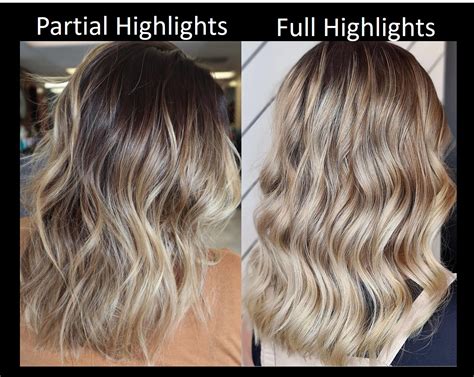When considering a hair color transformation, you’re inevitably faced with the decision between full and partial highlights. Understanding the nuances of each technique is crucial for achieving your desired look. This comprehensive guide will delve into the key differences between full and partial highlights, helping you make an informed choice.

Full Highlights: Amplifying Radiance
Full highlights involve meticulously distributing bleach or lightening agents throughout your hair, creating a luminous, uniform effect.
Benefits of Full Highlights:
- Overall Illumination: Evenly distributed highlights add vibrancy and dimension to your hair, enhancing its natural radiance.
- Versatile Canvas: Full highlights provide a versatile foundation for additional color treatments, allowing you to experiment with different shades and tones.
- Low-Maintenance: Once applied, full highlights tend to require less frequent touch-ups compared to partial highlights.
Drawbacks of Full Highlights:
- Costly and Time-Consuming: Full highlights can be more expensive and time-consuming to achieve than partial highlights.
- Potential Damage: The bleaching process involved in full highlights can lead to hair damage if not done properly.
Partial Highlights: A Subtle Glow
Partial highlights, also known as babylights or face-framing highlights, focus on strategically lightening specific sections of your hair.
Benefits of Partial Highlights:
- Subtle Dimension: Partial highlights add delicate dimension and movement to your hair without overwhelming its natural color.
- Affordable and Convenient: Partial highlights typically require fewer foils and less time than full highlights, making them a more cost-effective option.
- Minimal Damage: The limited application of bleach in partial highlights minimizes potential hair damage.
Drawbacks of Partial Highlights:
- Limited Coverage: Partial highlights can leave some areas of your hair untouched, resulting in less noticeable results compared to full highlights.
- Frequent Touch-Ups: The subtle nature of partial highlights often necessitates more frequent touch-ups to maintain desired results.
Table 1: Full Highlight vs. Partial Highlight Comparison
| Feature | Full Highlight | Partial Highlight |
|---|---|---|
| Coverage | Entire head | Specific sections |
| Effect | Uniform luminosity | Subtle dimension |
| Cost | Higher | Lower |
| Time | Longer | Shorter |
| Maintenance | Lower frequency | Higher frequency |
| Damage potential | Higher | Lower |
Choosing the Right Technique for You
The choice between full and partial highlights ultimately depends on your desired look, lifestyle, and hair health.
Full Highlights are ideal for:
- Those seeking a bold, vibrant hair transformation
- Individuals with naturally dark hair
- Those willing to invest in time and money for a long-lasting color
- Those who prefer a low-maintenance hair regimen
Partial Highlights are ideal for:
- Those desiring subtle color enhancement
- Individuals with fine or damaged hair
- Those seeking a more affordable and convenient option
- Those who prefer a more natural-looking result
Tips and Tricks for Enhanced Results
- Consult with a Professional: Seek the advice of an experienced hair stylist to determine the best highlight technique for your specific hair type and goals.
- Use High-Quality Products: Invest in reputable hair care products designed for color-treated hair to minimize damage and maintain vibrancy.
- Protect Your Hair: Minimize sun exposure and use heat-protecting products to prevent fading and damage.
- Regular Touch-Ups: Schedule regular touch-up appointments to maintain your desired color intensity.
- Embrace the Trend: Consider innovative highlight techniques such as balayage, ombré, or sombré to achieve unique and dynamic results.
Common Mistakes to Avoid
- Over-Bleaching: Avoid excessive bleaching, which can weaken your hair and lead to breakage.
- Neglecting Aftercare: Failing to follow proper aftercare instructions can shorten the lifespan of your highlights and damage your hair.
- Ignoring Professional Advice: Attempting to highlight your hair at home without professional guidance can lead to undesirable results and potential damage.
- Unrealistic Expectations: Understanding that each technique yields different levels of coverage and longevity can help set realistic expectations.
- Ignoring Hair Health: Prioritizing hair health by addressing any underlying damage before undergoing highlights can prevent further complications.
Table 2: Highlight Maintenance Timeline
| Highlight Type | Touch-Up Frequency |
|---|---|
| Full Highlight | Every 8-12 weeks |
| Partial Highlight | Every 4-6 weeks |
Table 3: Average Cost of Highlights
| Highlight Type | Average Cost |
|---|---|
| Full Highlight | $150-$450 |
| Partial Highlight | $50-$200 |
Table 4: Pain Points and Motivations for Highlighting
| Pain Point | Motivation |
|---|---|
| Fading hair color | Enhance radiance |
| Dull and lifeless locks | Add dimension |
| Gray hair | Cover |
| Desire for a change | Experiment with color |
Conclusion
Whether you opt for full or partial highlights, the ultimate goal is to elevate your hair color and boost your confidence. Embrace the information presented in this guide and consult with a professional stylist to achieve a stunning and personalized hair transformation.
